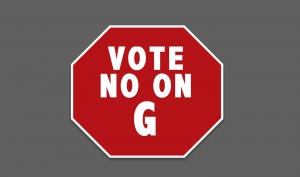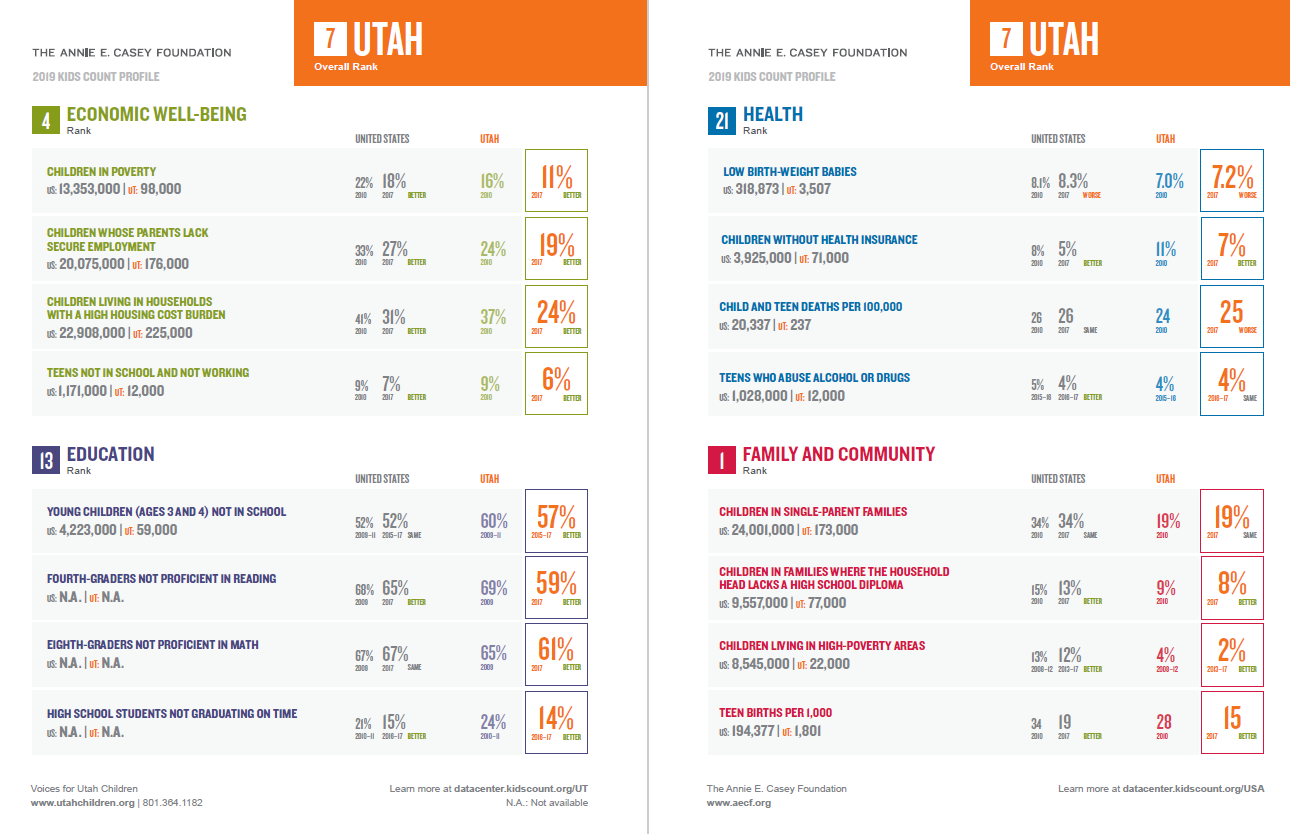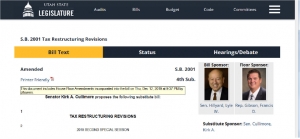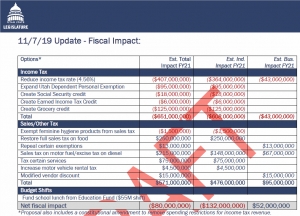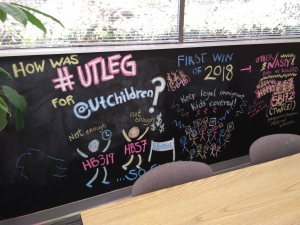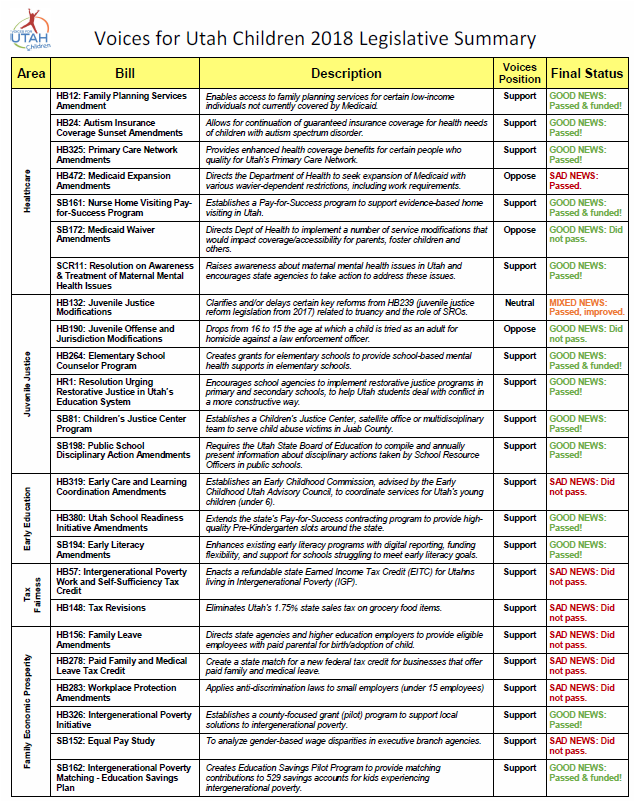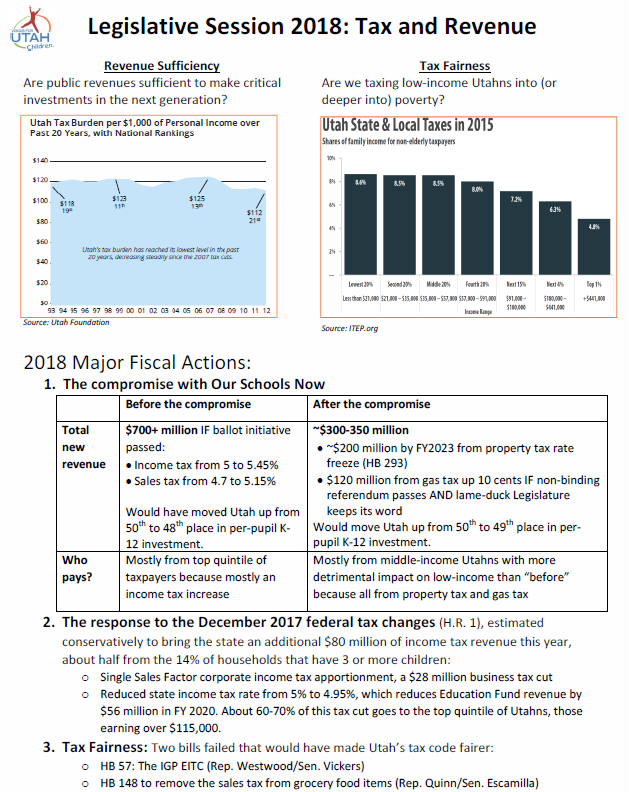State Policy
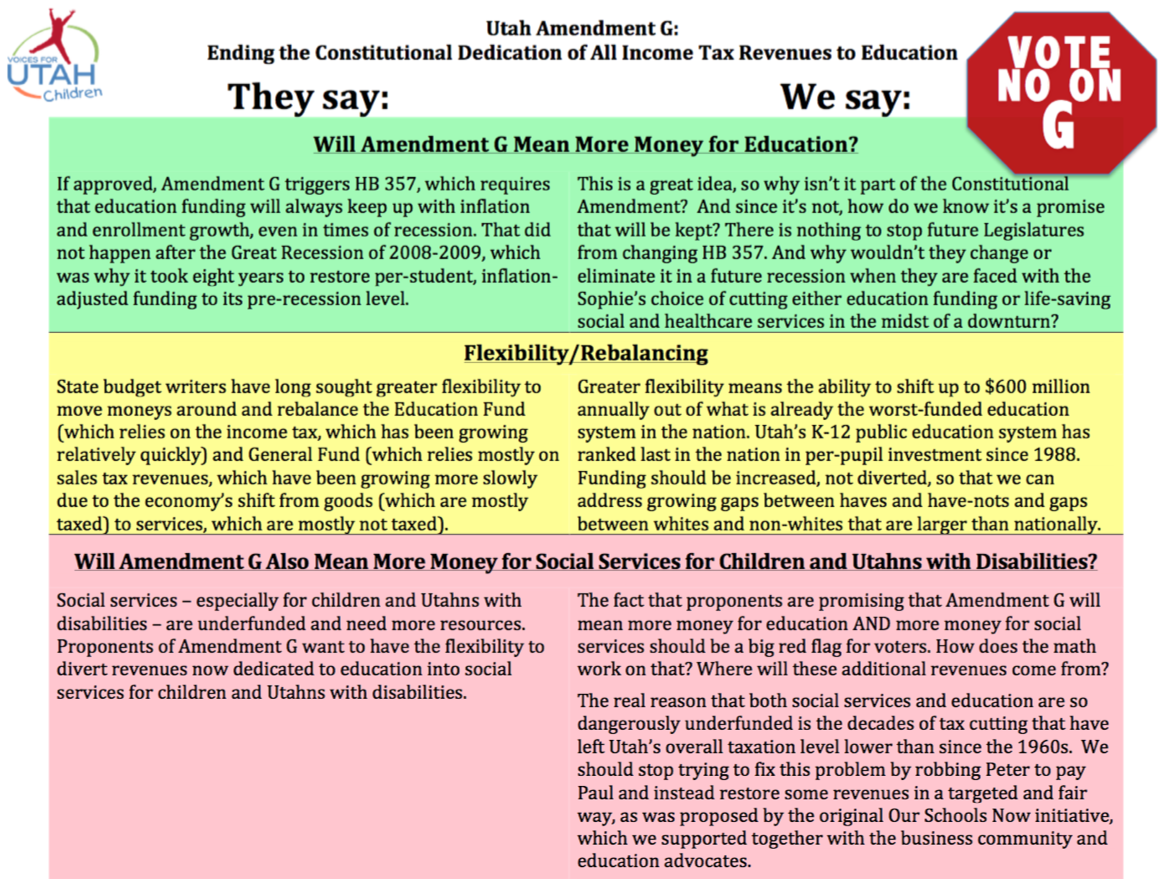
The state's leading child research and advocacy organization Voices for Utah Children announced its opposition to Constitutional Amendment G in an online press conference today (Monday, October 5, 2020).
Constitutional Amendment G is the proposal to amend the Utah State Constitution to end the Constitutional earmark of all income tax revenues for education. Since 1946 Utah has dedicated 100% of income tax revenues to education, initially defined only as K-12 education and, since 1996, including also higher education. The State Legislature voted in March to place on the ballot the question of also allowing these funds to be used for other purposes -- specifically for programs for children and for Utahns with disabilities.
The arguments made by proponents and opponents are summarized in an online document prepared by the state election administrators in the Lt Governor's office. According to that document, "the state spends about $600 million annually of non-income tax money on programs for children and programs that benefit people with a disability."
Voices for Utah Children CEO Maurice "Moe" Hickey explained the organization's decision to oppose the Amendment: "We believe that the proposed Amendment not only won’t solve Utah’s state budget woes, it is likely to delay the real fiscal policy changes that are needed. Over the past decade we have been continuously ranked last in the country for per pupil spending. This is a caused by our growth in number of students, combined with a lowered tax burden in the past decade. A major question we have to ask is “if the current Constitutional earmark has failed to help Utah invest more in education, how will getting rid of it improve matters?” The unfortunate reality is that getting rid of the Constitutional earmark of income tax for education does nothing to solve the real problem, which is the fact that nearly every area of state responsibility where children are impacted – education, social services, public health, and many others – is dangerously underfunded."
Health Policy Analyst Ciriac Alvarez Valle said, "Utah has one of the highest rates of uninsured children in the country at 8% or 82,000 children, and we have an even higher rate of uninsured Latino children at almost 20%. It is alarming that even during this pandemic, children and families are going without health insurance. There are so many ways to reverse this negative trend that began in 2016. Some of the solutions include investing in our kid’s healthcare. By investing in outreach and enrollment efforts especially those that are culturally and linguistically appropriate for our communities of color, we can ensure they are being reached. We also have to invest in policies that keep kids covered all year round and ensures they have no gaps in coverage. and lastly, we have to invest in covering all children regardless of their immigration status. By doing these things we can ensure that kids have a foundation for their long term health and needs. It's vital that we keep children’s health at the forefront of this issue, knowing that kids can only come to school ready to learn if they are able to get the resources they need to be healthy."
Health Policy Analyst Jessie Mandle added, "All kids need to have care and coverage in order to succeed in school. We are no strangers to the funding challenges and the many competing demands of social services funding. Without greater clarity, more detail, and planning, we are left to ask, are we simply moving the funding of children’s health services into another pool, competing with education funding, instead of prioritizing and investing in both critical areas? Sufficient funding for critical children’s services including school nurse, home visiting and early intervention, and school-based preventive care remains a challenge for our state. We have made important strides in recent years for children’s health, recognizing that kids cannot be optimal learners without optimal health. Let’s keep investing, keep moving forward together so that kids can get the education, health and wraparound services they need."
Education Policy Analyst Anna Thomas: "We often hear that UT is dead last in the nation in per pupil funding. We have also heard from such leaders as Envision Utah that millions of dollars are needed to avert an urgent and growing teacher shortage. What we talk about less is the fact that these typical conservative calculations of our state’s underfunding of education don’t include the amount the state should be paying for the full-day kindergarten programming most Utah families want, nor does it include the tens of millions our state has never bothered to spend on preschool programs to ensure all Utah children can start school with the same opportunities to succeed. Utah currently masks this underfunding with dollars from various federal programs, but this federal funding is not equitably available to meet the needs of all Utah children who deserve these critical early interventions. The state also increasingly relies on local communities to make up the difference through growing local tax burdens - which creates an impossible situation for some of our rural school districts, where local property tax will never be able to properly fund early interventions like preschool and full-day kindergarten along with everything else they are responsible for. Our lack of investment in early education is something we pay for, much less efficiently and much less wisely, later down the road, when children drop out of school, experience mental and physical health issues, and get pulled into bad decisions and misconduct. If kids aren’t able to hit certain learning benchmarks in literacy and math by third grade, their struggles in school - and often by extension outside of school - multiply. We should be investing as much as possible in our children to help ensure they have real access to future success - and can contribute to our state's future success. You don’t have to be a math whiz - third grade math is probably plenty - to see that the general arithmetic of Amendment G, and the attendant promises of somehow more investment in everything that helps kids - just doesn’t add up. We have multiple unmet early education investment obligations right now. Beyond that, we have many more needs, for children and for people with disabilities, that we must be sensitive to as a state especially during a global pandemic. How we will ensure we are investing responsibly in our children and our future, by having MORE expenses come out of the same pot of money - which the legislature tells us every year is too small to help all the Utah families we advocate for - is still very unclear to me. Until that math is made transparent to the public, we have to judge Amendment G to be, at best, half-baked in its current incarnation."
Fiscal Policy Analyst Matthew Weinstein shared information from the Tax Commission (see slide #8) showing that Utah's overall level of taxation is now at its lowest level in 50 years relative to Utahns' incomes, following multiple rounds of tax cutting. He also shared recent survey data from the Utah Foundation showing that three-fourths of Utahns oppose cutting taxes further and are ready and willing to contribute more if necessary to help solve the state's current challenges in areas like education, air quality, and transportation. He contrasted the public's understanding that there's no "free lunch" with the unrealistic election-year promises made by our political leadership -- more money for both education and social services if the public votes for Amendment G -- even though Amendment G does nothing to reverse any past tax breaks and address the state's chronic revenue shortages.
The organization shared a one-page summary of the arguments for and against the proposed Constitutional Amendment:

The organization also published a full five-page position paper that is available in pdf format.
State Policy
Invest in Utah Children!
State Policy Agenda
All kids have health care coverage and access.
All kids get the care they need from their parents and families.
All kids have a chance to live in economically prosperous families.
All kids start school ready to learn and thrive.
All kids have equal access to justice in schools and community.
Click here for our 2020 Utah Election’s Guide
2020 Election Guide to Issues Affecting Children
2020 Election Issues Guide
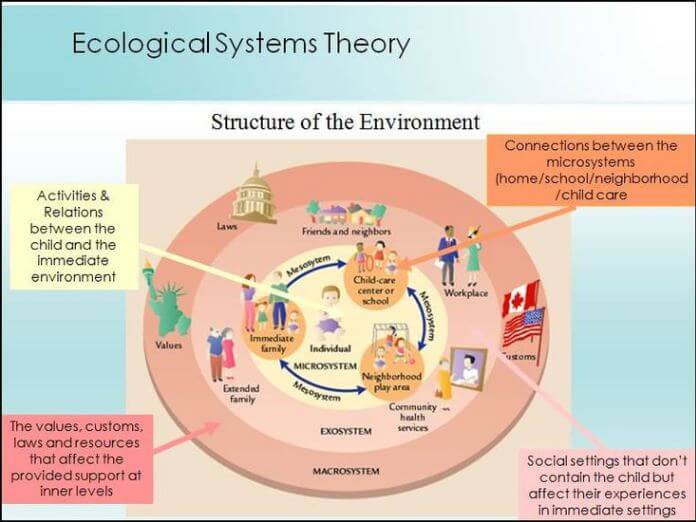 American psychologist Urie Bronfenbrenner formulated the Ecological Systems Theory to explain how the inherent qualities of children and their environments interact to influence how they grow and develop.
American psychologist Urie Bronfenbrenner formulated the Ecological Systems Theory to explain how the inherent qualities of children and their environments interact to influence how they grow and develop.
As Utah grapples with the effects of the coronavirus and COVID-19, this election year challenges us all to think bigger, broader, and longer-term. What lessons must we learn from the public health emergency? What has worked and has not in the actions already taken by state and local authorities? What weaknesses in Utah's economic and social structures were exposed by the pandemic that demand increased attention by Utah's next governor and legislators? What challenges can we now see that we should have addressed years ago to improve our resilience and ability to adapt to emergency circumstances?
While it is certainly true that the direct health effects of the coronavirus impact older adults the most, it is Utah's children who may bear the most lasting scars. Unable to attend school in person, relying on their parents or guardians to be their "home teachers" in a new sense, we already know that tens of thousands of Utah's children will fall behind in ways that will be difficult to make up. The decisions that our new governor and legislators make in the years to come will determine whether and how much our social and economic gaps expand as a result.
The public offices on the ballot in November include:
- Governor and Lt. Governor
- Half of the State Senate
- The entire Utah House of Representatives
Our elected officials play a central role in determining whether all Utah's children have the opportunity to achieve their potential. Will they have access to healthcare and education? Will their families enjoy the economic stability they need to thrive? These are all questions that will be answered by Utah's next governor and legislature.
Voices for Utah Children is providing this Election Issues Guide so that candidates for elected office can better understand the challenges facing Utah's children. We are also seeking to encourage public awareness and dialogue about the needs of children during this year's campaigns so that our new governor and legislature will begin their terms of office prepared to enact effective policies to protect their youngest constituents.
We have divided this Election Issues Guide into five sections:
Tax & Budget/Economic Performance
The Election Issues Guide can also be downloaded as a ![]() 15-page pdf at this link for easier printing.
15-page pdf at this link for easier printing.
Supported by the Annie E. Casey Foundation, our KIDS COUNT® work aims to provide Utah’s legislators, public officials and child advocates with reliable data, policy recommendations and other tools needed to advance the kinds of sound policies that benefit children and families across the state.
In 2019, Utah held on to its ranking among the top ten in the annual Annie E. Casey Foundation KIDS COUNT® Data Book report, coming in at 7th highest in the nation. We especially shined in the subcategory of "Family and Community," where we ranked #1 thanks to our highest-in-the-nation share of two-parent families and low share of children growing up in high-poverty neighborhoods. We also ranked 4th highest in the subcategory of "Economic Well-Being" thanks to our relatively low share of children in poverty.
But we failed to make the top ten in the other two subcategories in the KIDS COUNT® rankings, due to the fact that public policy has fallen short in precisely those two areas: education and health care. We barely outperformed the nation for high school graduation (and fell behind after adjusting for demographics). And we fell behind in the share of children with health insurance, especially among Utah's Latino children, who suffer from the highest uninsured rate in the nation.
All the KIDS COUNT® ranking details are viewable on the chart and links below.
Terry Haven 
Deputy Director
Voices for Utah Children
More Information:
Measures of Well-Being in Utah, 2019
Talking Kids Tour 2019 - A Supplement to the 2019 Utah KIDS COUNT Data Book
Every Utah child deserves the opportunity to reach their full potential, no matter where their family comes from or where they live in our state. No family should be denied care or afraid to seek the care they need. We must ensure that all Utah parents and kids have affordable health coverage and care. That is why Voices for Utah Children spearheads the 100% Kids Coverage Campaign, so that all children in Utah have insurance. Together we can promote healthy communities where all Utah families thrive.
All Utah children, families, and communities should have access to:
 Pre-natal care and insurance, including mental health support for caregivers;
Pre-natal care and insurance, including mental health support for caregivers;- Continuous, comprehensive health coverage and care for all Utah kids;
- Healthy communities and environments, including access to healthy food, clean drinking water and clean air.
To learn more about the 100% Kids Coverage Campaign visit: https://utahchildren.org/issues/100-kids-covered
Contact Jessie Mandle or Ciriac Alvarez Valle


More Information:
What Does the Coronavirus Mean for Families’ Access to Health Care?
New Report Finds Number of Uninsured Latino Children in Utah on the Rise
Voices for Utah Children Opposes New Trump Administration Medicaid Block Grant Guidance
Voices for Utah Children opposes Trump Administration Public Charge Rule
Voices for Utah Children celebrates Utah Medicaid Expansion
Voices for Utah Children believes in a youth-centered juvenile justice system that meets the needs of the children involved in it, while producing positive outcomes for Utah families and protecting community safety. We are committed to the belief that children should be nurtured, educated and given an equitable chance at success in life. That means allowing young people to make mistakes, learn from them, develop accountability to themselves and their communities, and work through their own unique challenges as they prepare for their lives as adults.
Voices for Utah Children advocates for juvenile justice system that is fair, effective and equitable. Such a system creates positive outcomes for different children, using evidence-based and culturally-competent programs, that meets the needs of children from a variety of socioeconomic backgrounds, races, ethnicities, physical and mental abilities, religious paths and belief systems, and sexual orientations and gender identities. We'll know that Utah has a fair, effective and equitable system when the youth themselves, their families and their communities, believe that the system is working in their best interest. In addition, we will see existing disparities between children of different races - in terms of contact with the system, the seriousness of dispositions, and the barriers to exiting the system quickly - disappear.
While we actively engage in policy analysis and advocacy directed at the policymakers who are able to remore structural barriers to youth success, we also work to empower advocates and community members alike, arming people with information that allows them to advocate for the young people in their lives who may be system-involved or at risk for system involvement.
More Information:
April 6, 2020 COVID-19 Update on Utah's Juvenile Justice System in: English, Spanish
April 27, 2020 COVID-19 Update on Utah's Juvenle Justice System in: English, Spanish (Part 1 & Part 2)
Good News for Juvenile Justice Reformers, from the 2019 Legislative Session
Report: Utah children face barriers to accessing defense attorneys
Let's End Racial Disparities in Utah's Juvenile Justice System
 Anna Thomas, MPA
Anna Thomas, MPA
Senior Policy Analyst
Voices for Utah Children
The early years in a child’s life are critically important in terms of social, emotional and cognitive development. All children deserve to start their lives with a real chance to succeed and be happy later in life, but not all children have access to the things that set them up for that kind of future. We believe that when the wellbeing of young children is at the center of public policy and community investment, our entire state does better.
That is why Voices for Utah Children focuses on promoting targeted investments in early childhood care and education, structured to meet the unique needs (and build on the unique strengths) of Utah's many diverse communities. We believe it is possible to build an early childhood system in Utah that supports families with young children by making sure they have access to affordable and appropriate options for their children’s early care and learning—whether children spend their days at home, in formal child care, at public school, or in the care of trusted family and friends.
Anna Thomas, MPA
Senior Policy Analyst
Voices for Utah Children
More Information:
There’s No “Re-Opening” Utah Without More Child Care
National Orgs Call for Emergency Child Care Sector Relief
Three Things Utah Can Do to Ensure Right-Sized Access to Full-Day Kindergarten
Kinship Care Families Need Our Support
Tax & Budget/Economic Performance
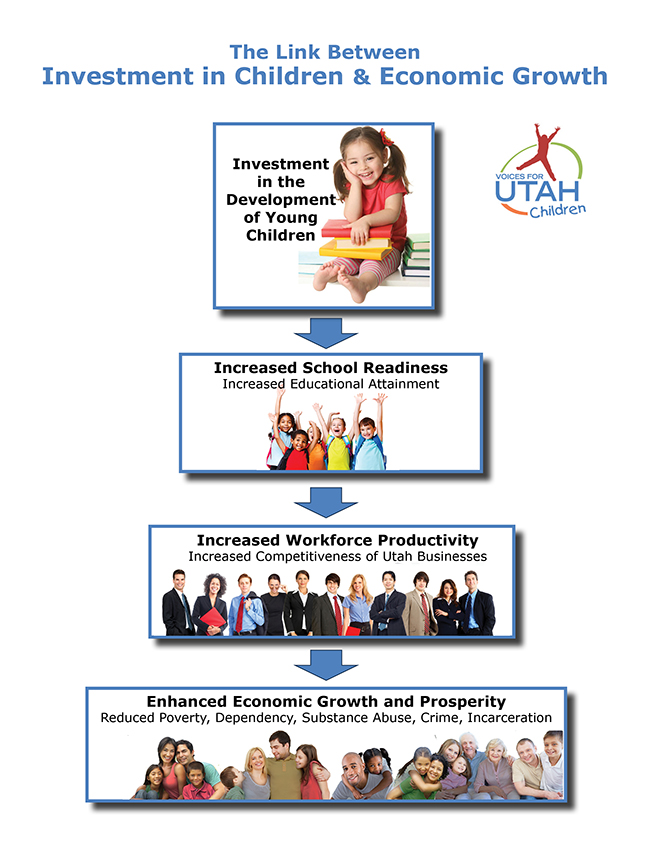
Tax and Budget: Every year, Utah's taxes (income, sales, gas, and property taxes) generate revenues that government then expends in ways that profoundly affect families and communities. The fiscal choices Utah makes — such as whether to invest in Utah's future or give in to the temptation to cut taxes below their current overall low level — will make a critical difference in the lives of the next generation of Utahns. If we make the best choices, we can help foster opportunity for all our children and lay the foundations for Utah's future growth and prosperity.
Last year the Utah State Tax Commission and the Utah Foundation both published research showing that taxes in Utah are the lowest that they have been in 30-50 years, following repeated rounds of tax cutting. Tax cutting is undoubtedly popular, especially in election years, but is it always wise? At some point we need to ask ourselves a difficult question: Is the current generation of Utahns doing our part, as earlier generations did, to set aside sufficient resources every year to invest in our children, in our future, in the foundations of tomorrow’s prosperity and quality of life? And more immediately and specifically, given the Coronavirus Recession's expected impacts on the Utah state budget, should we reconsider the 2018 election-year decision to reduce our income tax rate from 5% to 4.95%, a $50 million tax cut that mostly benefitted high-income households?
Voices for Utah Children's fiscal policy program works to ensure that we invest sufficient resources to ensure that our kids get world-class education and health care as well as special support for children most in need.
At the same time, we also work to ensure that public revenues are generated in ways that are fair. No family should be taxed into poverty as the price of educating their children. Currently, while we've moved in a better direction over the past 25 years, Utah does tax about 100,000 families into or deeper into poverty every year. In addition, the lowest-income Utahns pay a higher overall tax rate (7.5%) than those with the highest incomes (who pay 6.7% of their incomes in state and local taxes). That's one of the reasons why Voices for Utah Children supports making Utah the 30th state in the nation with our own Earned Income Tax Credit (EITC), starting with Utahns working their way out of intergenerational poverty.
Economic Performance: Voices for Utah Children examines and reports on Utah's economic performance from the perspective of how low- and moderate-income Utahns experience the economy -- some examples appear in the links below.
Matthew Weinstein, MPP 
State Priorities Partnership Director
Voices for Utah Children
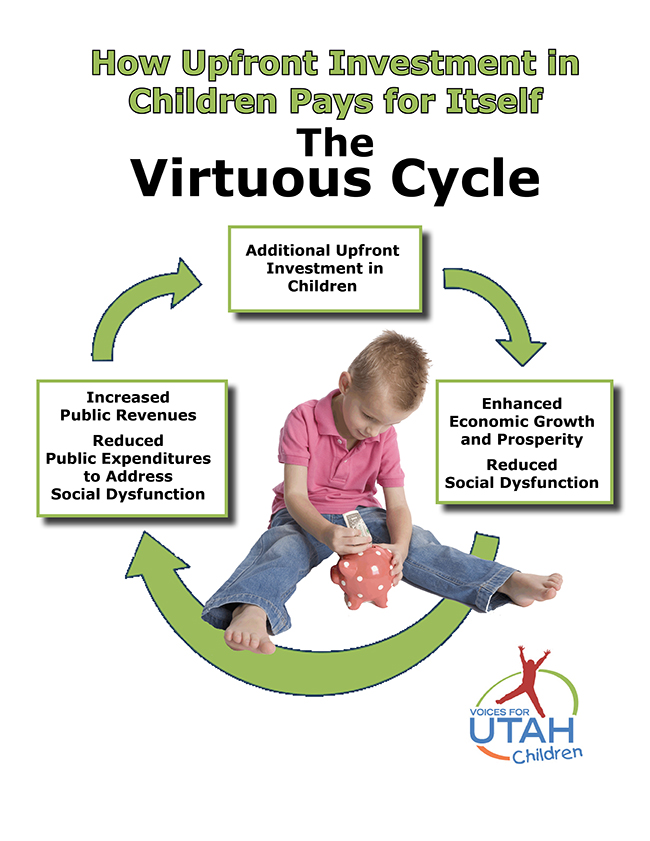
More Information:
Why Utah Should Invest In Our Future, Not Tax Cuts
Why Should Utah Become the 30th State with Our Own Earned Income Tax Credit (EITC)?
The History of Tax Incidence in Utah 1995-2018
Inequality in Utah Compared to Other States and the Nation
Utah Working Families Economic Performance Benchmarking Project: Utah vs. Idaho
Legislature Passes Tax Package Including Revenue Losses, Grocery Tax (and Credit), EITC
Last night, December 12, 2019, the Utah Legislature passed a tax restructuring package in a special legislative session.
Voices for Utah Children was very involved in this process over the course of the year. We attended the Tax Restructuring and Equalization Task Force (TRETF) hearings, generated public comment, released our position paper in September, and later that month participated in a poverty advocates' coalition letter signed by 27 non-profits that work with and advocate for lower-income Utahns. We published two op-eds on September 14 and November 26 as well as numerous blog and Facebook posts and tweets. We also worked directly with Task Force members to evaluate and shape the Task Force proposals.
From the start, we focused on two questions:
- Does the tax proposal reduce the regressivity in Utah's tax system so that we are taxing fewer Utah families into - or deeper into - poverty? Currently, Utah's overall tax system is regressive, in the sense that lower- and middle-income Utahns pay a higher overall tax rate than upper-income Utahns.
- Does the tax proposal enable Utah to invest more in the long run in Utah's children -- their education, their health, their future prospects to become productive members of their communities and of our state? The State Tax Commission and the Utah Foundation have both published research this year documenting that our overall level of taxation stands at a multi-decade low, raising the question of whether the current generation of Utahns is doing our part, as earlier generations did, to set aside sufficient resources every year to invest in our children. As the poverty advocates' coalition letter detailed, our decades of tax cutting have left Utah with billions of dollars in urgent unmet needs in numerous areas.
So how did the final bill passed last night stack up according to these criteria?
Will it reduce regressivity?
While the idea of bringing back the full sales tax on food was not a part of our proposals, and in fact we proposed eliminating the sales tax on food entirely, our analysis of the near-final version of the bill found that, overall, it will reduce the impact of Utah's taxes for lower-income Utahns from 7.5% of their incomes to 7%, or by about $100 per year, IF they file for the new Grocery Tax Credit (GTC).
The Legislature’s analysts estimate that 30,000-50,000 low-income Utah households do not file taxes every year, because their incomes fall below the mandatory minimum. Thus, in order to maximize the number of households who file for the credit, Voices for Utah Children proposed, fought hard for, and, on the final day, won inclusion in the package of $500,000 to market the new tax credit to its target population. We also recommended that the bill be amended to add an automatic inflation adjustment for the GTC so that it would not lose its value over time, but that was not included in the bill.
Grocery Tax Credits have considerable drawbacks (mainly that they require the filing of paperwork to obtain them) and vary greatly among the half-dozen states that have them. But the one passed last night will likely be the most generous and accessible one in the nation for lower-income households, based on the amount of the credit, its eligibility rules, and the commitment to invest substantial resources to publicize it.
The bill also makes Utah the 30th state with our own Earned Income Tax Credit (EITC), amounting to 10% of the federal credit and fully refundable, aimed at the 25,000 working families in Utah's intergenerational poverty (IGP) cohort. The inclusion of this provision – which was pulled from the bill for several very tense hours Thursday afternoon – is a credit to the persistence of Rep. Robert Spendlove, the sponsor of HB 103, chair of the House Revenue and Taxation Committee, and member of the TRETF. This is something that many Utahns have sought for decades, and Voices for Utah Children is grateful to the dozens of partnering organizations that have advocated for it alongside us in recent years.
Will it invest more in children?
Unfortunately, the answer here is no. The Governor and Legislature gave in to the election-year temptation to boast about a big tax cut. The bill reduces income taxes by over $600 million and replaces less than $500 million of that revenue with new sales taxes, leaving the state with $160 million less revenue every year going forward to invest in Utah's children.
Voices for Utah Children had strongly advised against using the state's current temporary fiscal surplus to permanently reduce revenues. We see this as a missed opportunity to act now for the state's long-term future, especially given that the shift from income taxes to sales taxes brings in tens of millions of new dollars from non-Utahns, which would have made it possible to offer an in-state tax cut while enhancing revenues or at least holding them steady.
Moreover, the shift from the faster-growing income tax to the slower-growing gas and grocery sales tax raises the question of whether public revenues will keep up with our fast-growing economy and population in the years to come, a point noted by Rep. Tim Quinn at the final TRETF meeting this past Monday. On the positive side, the bill does expand the sales tax base to some services and closes some outdated sales tax exemptions, which are small but important steps in the right direction.
It is also noteworthy that, because of the income tax rate reduction from 4.95% to 4.66%, about half of the overall net in-state tax cut of about $200 million annually goes to the top quintile of Utahns, those making over about $120,000 per year, and most of that half goes to the top 1% of Utah households, those earning over about $590,000.
As detailed in the poverty advocates’ coalition letter, our state suffers from chronic revenue shortages in numerous areas due to our decades of tax cutting, and these shortages disproportionately impact lower-income households. They also keep Utah from getting out ahead of our next-generation challenges, such as closing the majority-minority gaps that are worsening over time, even as our non-white communities are growing and becoming a more integral part of every region of Utah.
Thus, it is clear that a major challenge remains before Voices for Utah Children and other advocates in the years to come to make the case to the public and policymakers that it is worth investing more in our children, not less.
In-State vs Out-of-State Effects: The Key to Tax Restructuring Success?
If someone told you that the key to the success of the Utah Tax Restructuring and Equalization Task Force may well be found in an examination of the in-state vs out-of-state effects of the current draft proposal, your eyes would probably glaze over and you might suddenly recall a dentist appointment that you had forgotten.
But wait! Please tell the dentist you’ll reschedule and take a few minutes to read on.
Kansas: Tax Cuts That Went Too Far
The greatest danger for Utah’s future in the current debate is that fans of anti-tax/anti-government Pied Piper Grover Norquist and former Kansas Governor Sam Brownback will try to take advantage of the political pressures of the coming election year to follow in the footsteps of Kansas and include in the package a large revenue reduction. After all, tax cuts are always popular, and Utah has been giving in to that temptation for years.
Yet we know what an economic disappointment those tax cuts were in Kansas (it turns out that underinvesting in education and infrastructure does not actually help grow the economy), leading to devastating losses in subsequent elections for the plan’s proponents. The suddenly more moderate (while still Republican) Kansas legislature subsequently rolled back the tax cuts (though the voter backlash went on, electing a Democratic Governor last year in that very red state).
Apparently, it is possible to have too much of a good thing, even when it comes to tax cuts.
Successive rounds of tax cuts have left Utah with our lowest tax levels in decades, according to recent data from both the Utah Foundation and the Utah State Tax Commission. According to the Utah Foundation, the tax cuts of the last two decades have moved us from having the 6th highest taxes in the nation to #31 (even as we continue to have the nation’s highest percentage of children to educate). The Tax Foundation says that today we rank in the top 10 states for our business tax climate. By all accounts, our economy is booming and generating all the jobs we need, with an unemployment rate currently measured at 2.7%. So is it wise at this stage to use our temporary budget surplus to make even more permanent cuts to state revenues? Such additional tax cuts seem likely to have one of two possible outcomes, neither very desirable: Either they could rev our job-creating engine to the point that we’re creating enough new jobs not just for the next generation of Utahns but for hundreds of thousands of Californians to move here as well, or they could undermine the educational and infrastructural foundations of our long-term economic prosperity, as was the case in Kansas. Indeed, the tax cuts of recent decades have already crippled our ability to invest in education, infrastructure, air quality, public health, poverty prevention, and so many other areas where we have urgent unmet needs.
Should We Apply the Solutions of the Past to the Challenges of Today?
Certainly there is a strong case to be made that the tax cuts of recent decades helped Utah achieve our current economic success. Perhaps our most significant economic achievement of the last 20 years is that Utah has moved from being a low-wage state to middle-wage status, based on our rank for median hourly wage over the last two decades (#39 in 2006 vs. #27 last year). But rather than applying the solutions of the past to the challenges of today, the progress we've made puts us in a new position and allows us to ask a new question: Now that we have achieved middle-wage status, how can we, in the decades to come, follow in the footsteps of states like Colorado and Minnesota and move toward becoming a high-wage state?
Utah Has Fallen Behind on Educational Attainment
The secret to those states’ success lies in their higher levels of educational attainment. But right now Utah is behind on educational attainment. It is well-known that our teacher attrition rates are too high and so are our class sizes. But it is less well-known that, adjusted for demographics, our high school graduation rate is also behind the national average. In other words, for example, if you are White or Latino in Utah, you are less likely to graduate high school than Whites or Latinos nationally. At the college level, we have fallen behind national trends for BA/BS+ attainment among our younger generation, with only 34% of Utahns ages 25-34 having graduated college compared to 36% nationally, according to the latest 2018 Census data.
Utah’s Next Great Challenge: Our Growing Majority-Minority Gaps
Moreover, Utah is in the midst of a demographic transformation that is enriching our state immeasurably but also bringing majority-minority gaps of a type and at a scale that our state has not had to confront in the past. Education Week magazine recently ranked Utah among the worst 10 states for our growing educational achievement gap between haves and have-nots. Now is the time to make the upfront investments that will help us avoid going the way of other states that failed to close those gaps when they had the chance to do so in the most cost-effective manner.
While there is little doubt that Utah does more with less better than any other state, we will not close our growing gaps and raise our educational attainment as long as we are stuck in last place for per-pupil investment. The unfortunate reality remains that our very real economic progress of recent decades has not resulted in increased investment in education. Rather, our total inflation-adjusted per-student state + local K-12 education revenues remained below pre-recession levels last year.
In-State vs. Out-of-State Effects
If we can agree that there could be real downsides to making additional cuts to state revenues in the proposed tax restructuring package, then what does this have to do with in-state vs. out-of-state effects of the proposed tax changes, and how could understanding those effects potentially save the package?
The answer is that the draft package’s roughly $600 million shift of revenues from income taxes to sales taxes also brings with it a less-noticed shift of about $100 million from in-state payers (aka Utahns) to out-of-state payers (non-Utahns). This is because a much higher share of the sales tax than of the income tax is paid by non-Utahns – about 25% of all sales tax revenues (though a much higher 40% for the gas tax and a much lower 5% for the grocery tax since tourists mostly eat prepared foods, which are already fully taxable). (That exact percent varies slightly from state to state. The state of Texas, for example, estimates that 21% of their sales tax is paid by non-Texans. while Minnesota estimates 23% for their sales tax.*)
The Implications of $100 Million of New Revenue from Out-of-State
The first implication of this $100 million shift is that the Task Force’s claim of an $80 million tax cut in their draft package actually understates the in-state tax cut (the tax cut for us Utahns) by roughly $100 million. This means that the draft package actually proposes a $180 million tax cut for Utahns -- in a package that costs the state $80 million of revenue annually.
The further implication of this is that the package could very easily be adjusted (simply by changing the proposed income tax rate) to make it revenue neutral overall – and still have a $100 million tax cut for Utahns.
But, building on the discussion above about our urgent unmet needs and chronic revenue shortages, the best implication of this in-state vs out-of-state shift is that this package could achieve one of the holy grails of tax policy – getting non-Utahns to pay for the things we Utahns need (education, infrastructure, etc.) – by using the new out-of-state revenue to get this package out of the red and permit a $100 million revenue enhancement for the state budget without costing Utahns a dime.
The Compromise That Could Carry the Day
But politics is politics, and politicians are politicians, and next year is an election year. Which brings us to the compromise that could potentially save this package: Take that $100 million of new out-of-state money and split it 50-50: Make the package $50 million revenue-positive so we can improve education and infrastructure and use the other $50 million for an in-state tax cut. Which is probably not anyone’s ideal solution, but it just might be the compromise that can carry the day.
* Here are the reports from the Texas and Minnesota state tax agencies that analyze the topic of exporting tax incidence to non-residents:
- Texas -- https://comptroller.texas.gov/transparency/reports/tax-exemptions-and-incidence/ -- see Table 1 on page 47 (p53 of the pdf) which reports that 21% of Texas' $37 billion of sales tax incidence is exported to out-of-state payers.
- Minnesota -- https://www.revenue.state.mn.us/sites/default/files/2019-03/%2B2019_tax_incidence_study_Nolinks_0.pdf -- see Table 2-1 on page 26 (page 40 of the pdf) which reports that 23% of Minnesota's sales tax incidence is exported to non-Minnesotans.
Poverty Advocates Tax Reform Letter
Response to Govenor's Budget Recommendations FY2020
On December 6, 2018, Governor Herbert released his budget recommendations for the next fiscal year (2020). The budget is based on a consensus forecast developed by the Governor’s Office of Management and Budget, the Office of the Legislative Fiscal Analyst and the Utah State Tax Commission.
In summary, the budget recommendations reflect an estimated $1 billion in surplus revenue due to Utah’s booming economy; a $200 million tax cut and a call to modernize Utah’s tax system. The budget’s theme is Growth and Quality of Life and presents budget recommendations covering the following key areas: Quality of Life, Qualified Workforce, and Tax Modernization.
Voices for Utah Children works to make Utah a place where all children thrive. While reviewing the Governor’s recommendations we asked one simple, important question: "Is it good for kids?" If it’s good for kids that means Utah’s families can fully participate in the economy and support their children. That means parents are able to ensure their children reach their full potential and grow up ready to contribute to Utah’s thriving communities.
Continuing the Governor’s theme of Growth and Quality of Life, Voices staff have reviewed the budget and make the following observations:
1. Quality of Life
Funding for Medicaid Expansion Implementation
In November, Utahns expressed their clear support for Medicaid expansion and chose to extend health insurance to 150,000 new individuals. Utah voters elected to expand Medicaid to individuals and parents, without work requirements or caps. Voters even chose a small sales tax increase to support affordable health coverage. The Governor recognizes this historic step forward for Utahns in his budget recommendations and allocates funds for expansion implementation by April 1, 2019. The policy brief accompanying the budget also explores different scenarios and “what ifs” about the provider and consumer safeguards included in the ballot initiative; however, none of these questions preclude expansion from rolling out April 1st. It is paramount that individuals and parents in the coverage gap be able to enroll in coverage as soon as possible, without any added delays or restrictions, and we thank the Governor for supporting expansion funds in the budget.
Proposition 3 did not include any additional work requirements or barriers to care, as the Governor’s budget and policy brief also notes. Our new state law does not stipulate that Medicaid enrollees meet a work requirement as a condition to health coverage. We support exploring future programs that help connect Medicaid beneficiaries with job resources, training, or helps facilitate community engagement. However, we should not rush into changes and any work support program should not preclude someone from receiving coverage. As we have seen in other states, the complexities and confusion around reporting a work requirement often result in individuals unnecessarily losing coverage- even though they are working (See Arkansas’ recent experience). We support programs that help individuals be healthy and work; but people cannot work if they are not healthy.
Funding for Children’s Health Coverage
The Governor’s budget includes important funding recommendations to ensure that Utah children are covered, as demonstrated through Medicaid consensus figures. The Governor’s recommendations are particularly timely as recent data show an alarming increase in the number of uninsured children in Utah. In fact, Utah was one of only nine states to experience an increase in our child uninsured rate. We thank the Governor for extending a welcome mat to ensure that more children can receive health insurance. Going forward, there are additional steps we hope the Governor will support, so that more children do not lose health coverage: it is critical to ensure children can avoid unnecessary insurance loss or disruptions, by implementing a policy of 12-month continuous eligibility in Medicaid; in addition, Utah must counter the ‘chilling effect’ in health coverage due to federal policies targeting immigrant communities. We thank the Governor for his previous efforts encouraging qualifying parents to sign their children up for Children’s Health Insurance Program (CHIP). It is especially critical now that the Governor continue to create a welcoming, safe environment for Utah families to obtain affordable health coverage.
E-Cigarette Taxes
The Governor recommends a sales-tax increase on e-cigarettes. As the Governor notes, e-cigarette use is on the rise and can have a significant, harmful impact on the health of our youth. We are encouraged that the Governor recommends taxing e-cigarette and related paraphernalia like traditional tobacco products. This is an important step to keeping our kids healthy. National research shows e-cigarette use can be highest among some of our most marginalized youth, including LGBTQI, gender non-conforming and transgender youth. We hope that, in addition, state agencies will also ensure that 1) we are collecting state-level data to better understand impacted kids here in Utah and 2) we are providing the right kinds of care and services, so all kids feel affirmed, loved and supported.
Integrating Physical and Behavioral Health
We applaud the Governor for addressing Utah’s bifurcated healthcare system where different entities are responsible for physical and behavioral health services. The policy brief accompanying the budget discusses efforts to better integrate these systems. We hope that these efforts will also incorporate the behavioral health care needs of specific populations including children and new mothers. The behavioral health care needs of these populations are often overlooked and under-resourced. For example, women suffering from perinatal mood disorders - commonly called “maternal depression”- often have trouble finding treatment and care. Going forward, new efforts to better integrate services should make sure kids and parents can get the unique behavioral health care they need early on, before a condition escalates.
Jessie Mandle, Senior Health Policy Analyst
School Safety
When it comes to spending on “school safety,” the Governor’s budget has given us cause for concern. Governor Herbert appears to support the recommendations of the “School Safety Advisory Committee,” a group which has drawn criticism for its lack of representation and for conducting its business outside the public view.
In November of this year, this Committee presented a $194 million bill titled “School and Student Safety Amendments,” which designated $164 million for schools to upgrade their physical facilities with student safety in mind. In his budget, Governor Herbert includes $66 million in “flexible” funding for this same purpose. We have no problem with funding for schools to modernize and improve their infrastructure, as many schools are in need of basic maintenance anyway. Why not build in new safety features while modernizing facilities?
We appreciate that the Governor has set aside $31.7 million in his budget for a “school counseling program,” which appears to reflect a similar $30 million ask from the School Safety Advisory Committee during November interim. We applaud Governor Herbert for explicitly saying that this funding should be used for counselors. Mental health professionals, social workers, counselors and other professionals are critical for building a safe and positive school climate. Investing in prevention when it comes to bullying, violence and suicide makes more sense than trying to deal with the aftermath of these ongoing challenges.
Our concern about school safety funding arises from what is not said in the Governor’s budget, but which exists in the proposed legislation from the School Safety Advisory Committee: a mandate for each school in the state to form “Threat Assessment and Student Support Teams” that are authorized to respond to “significantly disruptive behavior” from students – whatever that may mean.
This approach, which is loosely based on a specific protocol that has yielded good results in other states, could jeopardize the recent juvenile justice reforms that received a great deal of well-deserved attention and praise in the Governor’s budget document. Utah’s impressive juvenile justice reforms have included a focus on using restorative, rather than punitive, practices in schools. This approach decreases the number of youth who are referred to court for very low-level offenses (such as truancy and smoking), incurring high costs to taxpayers and negative outcomes for the youth themselves. We are very concerned that the legislation recommended by the School Safety Advisory Committee does not align with these important reforms. We all want our kids to be safe at school, but not every proposed solution creates actual safety, and some approaches actually make some groups of students less safe. Voices for Utah Children will have much more to say on this subject as we move closer to the 2019 Legislative Session.
Anna Thomas, Senior Policy Analyst
2. Quality Workforce
Education
We at Voices, are particularly happy about the recommendations for sustained and improved funding of public education. Education is the key to future career success for so many Utah kids – and our teachers are key to education. That’s why we are so pleased with the Governor’s support for boosting teacher pay. When teachers do well, students do well.
We scoured the Governor’s budget for any mention of investment in early education with no luck. We’re not panicking yet. The Governor’s Education Road Map, released a year ago this month, included an entire section of recommendations related to early learning. We expect to see more investment in this area as current state-funded early education programs become better aligned and coordinated.
Child Care
We couldn’t help but notice the absence of any mention of state investment in – or even attention to – the pressing child care needs of Utah’s workers and students. We agree with Governor Herbert that “Utah must invest in its people to achieve long-term success,” and that “a dynamic economy requires a skilled and education population.”
Having the right skills and the willingness to work isn’t enough to make our workforce successful, though. More Utah workers than ever before are now also parents. They can’t be expected to engage productively in our thriving economy unless they have access to affordable, accessible child care. The state currently does a good job of managing federal dollars that help to subsidize child care costs for working parents but invests very few state tax dollars for this purpose. The Governor’s proposed budget would do little to change this.
The irony is, Utah doesn’t just need to fill “high-paying jobs” with “highly skilled” workers. We need many more individuals who are willing to work jobs that don’t pay well enough relative to their importance to our economic development. These critical jobs are in the early care and education sector. Currently, the Utahns who provide child care to working parents all over the state, barely make enough to keep their own families out of poverty.
One easy way the Governor could bolster state investment in child care, would be to provide sufficient funding for subsidized childcare while parents are attending college. The Governor’s budget rightly emphasizes the importance of higher education in creating opportunity to otherwise “at-risk” families. However, lack of affordable child care keeps many parents – moms, especially – from going back to school to enhance their earning potential. If Utah is serious about investing in the workforce, the Governor’s budget should prioritize investment in college-based child care centers such as the Wee Care Center at Utah Valley University and the Sorenson Legacy Foundation Child & Family Development Center at Southern Utah University.
Anna Thomas, Senior Policy Analyst
anna@utahchildren.org
3. Tax Modernization
Utah’s economic structure is moving from goods based to service based. Most purchased goods generate a sales tax. Some services are taxed, but many others enjoy a sales tax exemption or a reduced tax rate. The following table illustrates a few examples.
| State Sales Tax Bases: Consumer Goods & Services as of 7/1/18 | |
| Groceries | Alternate Rate |
| Clothing | Taxable |
| Prescription Medication | Exempt |
| Non-Prescription Medication | Taxable |
| Gasoline | Exempt |
| Legal | Exempt |
| Financial | Exempt |
| Accounting | Exempt |
| Medical | Exempt |
| Landscaping | Exempt |
| Repair | Taxable |
| Real Estate Services | Exempt |
| Parking | Exempt |
| Dry Cleaning | Taxable |
| Fitness | Taxable |
| Barber | Exempt |
| Veterinary | Exempt |
| Tax Foundation 2019 State Business Tax Climate Index | |
| https://files.taxfoundation.org/20180925174436/2019-State-Business-Tax-Climate-Index.pdf | |
| https://tax.utah.gov/sales/food-rate | |
| Utah grocery sales tax is 3%, a higher rate is charged if food items are mixed or combined by seller and/or heated by seller, or utensils are provided. | |
The increase in services as an engine for economic growth is not generating enough tax revenue to keep pace with the rising cost to build and maintain Utah’s infrastructure and provide services which support communities and keep the economy humming. As Utah moves to a service based economy, transactions generating sales tax have declined from about 70% (in the 1980s) to 40%. As a percent of income, 95% of Utah’s families pay more in sales and other local taxes than the top 5% of higher income families.

Source: https://itep.org/whopays/
This is not the first time the Governor has called for a tax overhaul. Removing a few exemptions is a commonsense way to broaden the tax base. It is time for special interests to do their part to boost revenues needed to pay for investments which support Utah’s Growth and Quality of Life.
Revenue Earmarks
Earmarks are revenue assigned to fund specific government projects, services or programs. For example, gas taxes are earmarked for transportation needs while a portion of tobacco taxes are designated to fund antismoking initiatives. The recent voter approved Prop 3 calls for a sales tax increase earmarked to expand Medicaid access.
The Governor wants to reform the state’s earmark policy. He notes that 48% of new sales tax revenue growth is earmarked in FY2020 and further argues that earmarks are not transparent and do not allow policy makers to prioritize the state’s most pressing needs. He proposes that some earmarks be replaced by user fees.
The online dictionary defines fee as “a payment made to a professional person or to a professional or public body in exchange for advice or services.” A tax is “a compulsory contribution to state revenue, levied by the government on workers' income and business profits or added to the cost of some goods, services, and transactions.” Whether it’s a tax or fee, broadening the tax base must be done fairly, equitably and shared by all.
Patrice Schell Scott, State Priorities Partnership Fellow
Register to Vote by October 30th
Kids can't vote. They need people who care about them (like you!) to vote for elected officials who will address their needs. Don't miss the next election.
You can register to vote at the polls on Election Day or during the Early Voting Period, but if you register beforehand:
- October 9, 2018: last day to register to vote by mailing in a registration form.
- October 30, 2018: last day to register to vote online or at your county clerk's office.
For 30 years now, Voices for Utah Children has called on our state, federal and local leaders to put children’s needs first. But the work is not done. The children of 30 years ago now have children of their own. Too many of these children are growing up in poverty, without access to healthcare or quality educational opportunities.
How can you be involved?
Make a tax-deductible donation to Voices for Utah Children—or join our Network with a monthly donation of $20 or more. Network membership includes complimentary admission to Network events with food, socializing, and opportunity to meet child advocacy experts. And don't forget to join our listserv to stay informed!
We look forward to the future of Voices for Utah Children and we hope you will be a part of our next 30 years.
Special thanks to American Express, our "Making a Difference All Year Long" sponsor. 
2018 Utah Legislative Update
The 2018 Legislative Session is over. Voices for Utah Children worked tirelessly to advocate for Utah’s children and families, and we had some great wins and some painful losses. Nonetheless, Utah children and families are in a better place now than they were in January.
Health
WIN: HB12 Family Planning Services Amendments (Rep. Ward)
- This legislation was championed by a number of Voices allies (YWCA, Utah Women’s Coalition, ACLU, and Planned Parenthood) to provide family planning services to low-income individuals through Medicaid
WIN: HB325 Primary Care Network Amendments (Rep. Eliason)
- This bill will direct the Department of Health to get a waiver to expand current PCN services for adults receiving coverage from the state.
DEFEATED: SB48 Medicaid Waiting Period Amendments (Sen. Christensen)
- This legislation would have re-imposed a five-year waiting period on legal immigrant children before they could enroll in health coverage. Our advocacy work helped ensure this bill never got heard
DEFEATED: SB 172 Medicaid Waiver (Sen. Hemmert)
- This bill would have done away with Medicaid’s children’s health benefit and EPSDT. This would have caused 2,600 parents and former foster youth to lose their health coverage. Voices defeated it in the House Health and Human Services Committee and again in the House Revenue and Taxation Committee.
LOSS: Keeping Kids Covered – 12-month continuous eligibility on Medicaid
- Rep. Ward appropriation requested wasn’t prioritized high enough to receive funding this year.
LOSS: Dental hygiene check-ups for kids in public education settings
- Dental Code for use by dental professionals providing hygiene check-ups for kids in public education settings - did not get prioritized high enough to be funded for this year - but we’ve strengthened our relationship with a huge association of highly motivated dental hygienists!
LOSS: HB472 Medicaid Expansion Revisions (Rep. Spendlove)
- HB472 seeks a waiver, that is highly unlikely Utah will receive from the Trump Administration. This waiver would provide Medicaid benefits to eligible individuals below 95% of the federal poverty level.
The Utah Decides Ballot Initiative is now our last hope to get Medicaid expansion done in 2018.
Early Childhood
LOSS - HB319 Early Care and Learning Coordination Amendments (Rep. Chavez-Houck)
- A priority bill to form an Early Childhood Commission for better governance and coordination among agencies offering services to Utah’s youngest kids (0 to 5).
WIN - HB380 Utah School Readiness Initiative Amendments – (Rep. Last)
- With a close collaboration with United Way of Salt Lake, this bill will continue the school readiness program, Pay-for-Success. Since 2014 this has provided thousands of at-risk kids in Salt Lake county with high-quality pre-school.
WIN - SCR11 Concurrent Resolution on Awareness and Treatment of Maternal Depression and Anxiety (Sen. Zehnder)
- With the efforts of the Maternal Mental Health Coalition, this resolution energized and inspired story-sharing and education on maternal mental health.
WIN: SB161 Nurse Home Visiting Pay-for-Success Program (Sen. Escamilla)
- This legislation will fully fund the Nurse Family Partnership by putting it forward as a Pay-for-Success Program.
Juvenile Justice
WIN: HR1 House Resolution Urging Restorative Justice in Utah’s Education System – (Rep. Sandra Hollins)
- Resolution to encourage the use of restorative justice practices in Utah schools
NOT A WIN BUT NOT A LOSS: HB132 Juvenile Justice Modifications (Rep. Snow)
- Updates to last year’s big juvenile justice reform effort - we fought hard with our allies (ACLU, Libertas Institute, YWCA, Racially Just Utah) to keep the changes to a minimum. This bill gives school a limited amount of time to update their programs to comply with HB239 from 2017.
WIN: SB198 – Public School Disciplinary Action Amendments (Sen. Anderegg)
- This legislation requires the Board of Education to produce an annual report looking at law enforcement and disciplinary action in schools. This data will be helpful as we work to reduce racial disparities in school discipline and work to build a system that produces better outcomes for all kids.
Tax and Budget
NOT QUITE A WIN BUT OH SO CLOSE: HB57 Utah Intergenerational Poverty Work and Self-sufficiency Tax Credit (Rep. Westwood/Sen. Vickers)
- This bill would have created a $6 million Earned Income Tax Credit (EITC) for 25,000 working families identified as being in the Intergenerational Poverty (IGP) cohort by the state Department of Workforce Services. These families, which pay tens of millions of dollars in state and local taxes every year, would have been able to keep more of what they earn with a tax credit averaging $240 (and up to $600 maximum). This legislation received unanimous support in both House and Senate committees, passed the House, and received a 22-4 vote on 2nd reading in the Senate. But on the final day of the session, leadership decided to leave it out of the final tax package.
NOT QUITE A WIN BUT COULD HAVE BEEN A LOSS --SCHOOL FUNDING
- The most notable fiscal outcome of the 2018 Legislative Session was a deal between legislative leadership and education funding advocates. The compromise deal included two big choices:
- Investing up to about $350 million in new education funding dollars – which should move Utah up one position in the national rankings for per-pupil K-12 funding, from 50th place to 49th if it is fully implemented.
- Shifting who pays these new dollars in a way that unfortunately more negatively impacts poor and middle class families. The Our Schools Now initiative proposal that was set aside in favor of this compromise would have raised over $700 million mostly from an income tax increase paid by the top 20% of Utahn (those who earn over $115,000). The compromise shifted these funds to come from more regressive gas and property tax increases.
LOSS: HB 148: House Bill 148 Tax Revisions- Sales Tax on Food (Rep. Quinn)
- Sought to eliminate the state sales tax on grocery food items (currently 1.75%) and make up for the $88 million in lost revenue by slightly increasing the general state sales tax rate from 4.7 to 4.92%. One underappreciated benefit of this tax change would have been to shift 20% of the $88 million, or $17.6 million, off of state residents and onto tourists and out-of-state residents who purchase Utah exports. The bill passed the House but was killed by the Senate Revenue and Taxation Committee.
WIN: Two Significant Intergenerational Poverty (IGP) bills
- HB 326 Intergenerational Poverty Initiative (Rep. Redd) establishes a one-time $1 million grant program for local IGP initiatives.
- SB 162 Intergenerational Poverty Matching – Education Savings Plan (Sen. Vickers) establishes a $100,000 matching grant program for IGP families that invest in a Utah Educational Savings Plan for their children's post-secondary education.

